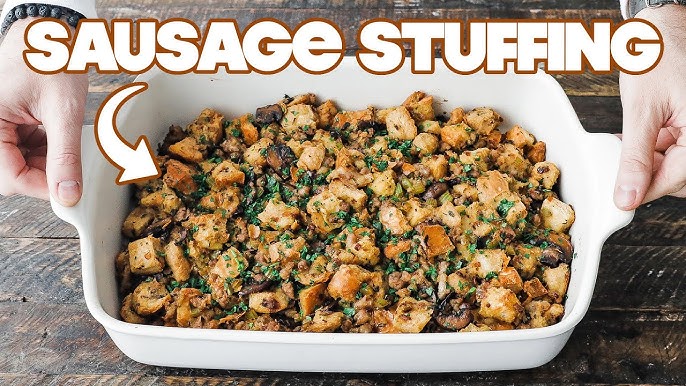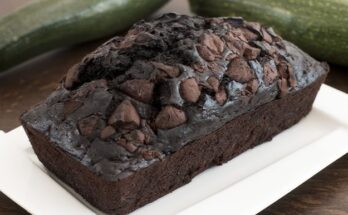Thanksgiving Stuffing Recipe: Thanksgiving isn’t complete without a big tray of savory, golden stuffing sitting proudly on the table. It’s one of those side dishes that instantly takes you back to family gatherings, laughter, and the smell of turkey roasting in the oven. Stuffing—or “dressing,” as some call it—has become a cherished staple of the holiday meal. But if you’re new to making it or want to perfect your version, this step-by-step guide will show you exactly how to create the ultimate stuffing from scratch.
What is Stuffing?
Stuffing is a flavorful dish made primarily of bread cubes, vegetables, herbs, and broth. It’s typically baked either inside a turkey or in a separate casserole dish. The beauty of stuffing lies in its versatility—whether you like it savory, slightly sweet, crunchy on top, or soft all the way through, there’s a variation for every preference.
Traditionally, stuffing was literally used to “stuff” the bird. But these days, for safety and texture reasons, many people prefer to bake it separately. The best part? It’s super easy to make with just a few staple ingredients, and you can easily put your own spin on it.
Importance of Stuffing in Thanksgiving Tradition
Stuffing has been on Thanksgiving tables since the earliest feasts. It’s believed to have evolved from old European recipes, where stuffing meats with grains, nuts, and herbs was a common practice. Over time, American cooks adapted it to include local ingredients like cornbread, cranberries, and sausage, turning it into the dish we know and love today.
Beyond its culinary role, stuffing symbolizes tradition. It’s often made from recipes handed down through generations, with each family putting their own twist on it. For many, the smell of sage and onion wafting from the oven means that Thanksgiving has truly begun.
Ingredients You’ll Need
Before we dive into the steps, let’s take a closer look at what goes into a great stuffing. Don’t worry—you probably have most of these ingredients in your pantry or fridge already.
Bread Options: Fresh vs. Stale
Bread is the heart of any stuffing. You want something hearty that will soak up the broth without turning into mush. Stale bread is actually ideal because it’s drier and more absorbent. If you’re using fresh bread, just cube it up and toast it in the oven at 300°F for 15–20 minutes until it’s dry but not browned.
Best bread choices:
- French bread
- Sourdough
- White sandwich bread
- Cornbread (for Southern-style stuffing)
- Whole grain (adds texture and nutty flavor)
Cut the bread into small cubes—around ½ to 1 inch—and make sure they’re evenly sized for even cooking.
Vegetables and Aromatics
This is where your stuffing gets its depth of flavor. Onions and celery are the classic combo, but you can get creative with mushrooms, leeks, or even fennel.
Must-have vegetables:
- Yellow onion – adds sweetness and aroma
- Celery – provides crunch and earthy flavor
- Garlic – optional, but gives a nice kick
Finely chop everything so that it cooks down and blends well into the stuffing. You’ll sauté these in butter (or olive oil for a dairy-free version) until soft and fragrant.
Herbs and Seasonings
Herbs are the soul of stuffing. The classic trifecta is sage, thyme, and rosemary, but you can also add parsley, marjoram, or poultry seasoning for an extra layer of flavor.
Spice tip: Fresh herbs will give you the most vibrant flavor, but dried herbs work fine in a pinch—just reduce the amount by half since dried herbs are more concentrated.
Don’t forget to season with salt and pepper throughout each step, not just at the end. Layering the seasoning ensures a rich, flavorful final dish.
Broth and Other Liquid Additions
Broth ties everything together and moistens the bread without making it soggy. Chicken or turkey broth is traditional, but vegetable broth works great for a vegetarian version. You can also add a beaten egg or two to help bind the mixture and create that nice, sliceable texture.
How much broth? That depends on how dry your bread is. Start with 2 cups and slowly add more if needed—your mixture should be moist but not wet.
Step-by-Step Guide to Making Classic Thanksgiving Stuffing
Now that we’ve covered the ingredients, let’s walk through the actual process of making stuffing from scratch. This step-by-step breakdown will guide you to a dish that’s moist, flavorful, and perfectly golden on top.
Step 1: Preparing the Bread Cubes
Start by cubing your bread into even pieces. As mentioned earlier, using day-old or oven-dried bread is key to achieving the right texture. You want the cubes to be dry so they can soak up all the flavors without turning into mush.
How to dry the bread:
- Spread the cubes on a baking sheet in a single layer.
- Toast at 300°F (150°C) for 15–20 minutes, tossing halfway through.
- Let them cool completely before using.
Drying the bread also enhances its toasty, nutty flavor, which adds a beautiful undertone to your stuffing.
Step 2: Sautéing the Vegetables
In a large skillet, melt butter over medium heat (about ½ cup or one stick for a large batch). Once it’s bubbling, add your chopped onions and celery. Sauté until they’re translucent and fragrant—about 10 minutes.
For extra flavor, throw in minced garlic during the last 2 minutes of cooking. If you’re including extras like mushrooms, now’s the time to add them as well.
Pro Tip: Don’t rush this step. Let the vegetables caramelize slightly for a richer taste.
Add your herbs next—chopped sage, thyme, rosemary, and parsley. Cooking them in butter releases their essential oils and boosts the aroma. Once everything is tender and well-seasoned, remove the pan from heat.
Step 3: Mixing Bread, Veggies, and Seasonings
Now it’s time to bring it all together.
In a large mixing bowl, combine your toasted bread cubes and sautéed veggies. Gently toss them so the bread gets coated with the buttery, herby goodness. This is your base, and it should already smell like Thanksgiving!
Sprinkle in salt and freshly ground black pepper. Taste as you go (before you add the eggs or broth). This is your chance to adjust the seasoning to perfection.
Want to take it up a notch? Add a few optional ingredients at this stage:
- Cooked, crumbled sausage for a hearty touch
- Chopped apples or dried cranberries for a sweet contrast
- Toasted pecans or walnuts for crunch
Just be sure not to overload the mixture—balance is key.
Step 4: Adding the Broth and Eggs
In a separate bowl, beat 1–2 eggs (depending on the quantity of stuffing). Pour them over the bread mixture and gently fold everything together. The eggs act as a binder, helping the stuffing hold its shape once baked.
Next, slowly drizzle in the broth, a little at a time. Toss gently after each addition. The goal is to moisten the bread without making it soggy. You want the bread to absorb the liquid but still hold some structure.
Texture check: When you press a handful together, it should hold but not drip. If it feels too dry, add more broth in small increments.
Let the mixture sit for 10–15 minutes so the flavors meld and the bread fully absorbs the moisture. This resting time really makes a difference in the final texture.
Step 5: Baking to Golden Perfection
Preheat your oven to 350°F (175°C). Grease a baking dish with butter or non-stick spray, then spoon in your stuffing mixture. Don’t pack it too tightly—you want air to circulate for a nice crust.
Bake uncovered for about 35–45 minutes until the top is golden brown and crispy. If you prefer a softer top, cover with foil for the first 30 minutes and uncover for the last 10–15 minutes to let it brown.
For a more intense flavor and crispiness, you can bake it in a cast-iron skillet or spread it thinly on a sheet pan for more surface area.
Once it’s done, let it cool slightly before serving. This allows it to set and makes it easier to slice or scoop.
Tips for Customizing Your Stuffing
Stuffing is a blank canvas, and the best part is how customizable it is. Here’s how you can switch things up to suit your tastes or dietary needs.
Adding Sausage or Bacon
Want a meatier version? Brown some sausage or bacon and mix it into the bread mixture before baking. Pork sausage with sage works especially well and gives the dish a comforting, savory punch.
Other tasty additions:
- Italian sausage for a spicier kick
- Pancetta or prosciutto for a fancier feel
- Turkey sausage to keep it lean
Make sure to drain any excess fat before adding the meat to avoid greasy stuffing.
Making it Vegetarian or Vegan
Going plant-based this Thanksgiving? No problem! Simply use vegetable broth instead of chicken, and swap the butter for olive oil or a vegan alternative.
For a vegan binder, skip the eggs and use a flaxseed “egg” (1 tbsp ground flaxseed + 3 tbsp water = 1 egg), or just add a bit more broth and mash up some of the bread cubes to help bind everything.
Roasted vegetables, wild mushrooms, and dried fruit can add extra richness and depth to a meat-free stuffing.
Incorporating Fruits and Nuts
For a sweet and savory twist, fruits and nuts can take your stuffing to the next level. They add both texture and bursts of unexpected flavor, making each bite more exciting.
Popular additions:
- Dried fruits: Cranberries, apricots, raisins, cherries
- Fresh fruits: Apples or pears, diced small
- Nuts: Chopped pecans, walnuts, or almonds
To incorporate these, add them in with your bread mixture before baking. If you’re using dried fruits, soak them in warm water or broth for 5–10 minutes first to plump them up. This will keep them from drawing too much moisture from your stuffing.
Just be mindful of the balance. A handful of each goes a long way. You don’t want the sweetness to overpower the savory base.
Common Mistakes to Avoid
Stuffing might seem simple, but a few missteps can turn this holiday favorite into a soggy or flavorless mess. Let’s talk about the common mistakes and how to avoid them.
1. Using Fresh Bread Without Drying It
Fresh bread is too moist and can lead to gummy stuffing. Always toast or let your bread sit out for a day or two to dry.
2. Over-Saturating with Broth
More broth doesn’t always mean better. Add it slowly, mix gently, and aim for a texture that’s moist but not mushy.
3. Underseasoning
Bread soaks up a lot of flavor, so be generous with your herbs and salt. Taste your mixture before baking—if it tastes good raw, it’ll taste great baked.
4. Skipping the Resting Step
Letting the bread sit after adding the broth helps ensure it’s evenly moistened and infused with flavor. Don’t skip it!
5. Packing the Dish Too Tightly
Give the stuffing some breathing room. Pressing it down too firmly can make it dense and prevent that crisp, golden top.
By keeping an eye out for these pitfalls, your stuffing will come out delicious every single time.
Storing and Reheating Leftovers
Thanksgiving leftovers are half the fun—and stuffing is one of the best to save. Here’s how to keep it fresh and tasty for the days after your feast.
Storing:
- Cool stuffing completely before storing.
- Place in an airtight container or wrap tightly with foil.
- Refrigerate for up to 4 days.
Reheating:
- Preheat oven to 350°F (175°C).
- Add a splash of broth to prevent drying out.
- Cover with foil and heat for 20–30 minutes, or until warmed through.
- For a crispier top, remove foil for the last 10 minutes.
You can also reheat smaller portions in the microwave, but the oven method keeps the texture intact best.
Freezing: Yes, stuffing freezes well! Store in a freezer-safe container for up to 3 months. Thaw overnight in the fridge before reheating.
FAQs about Thanksgiving Stuffing Recipe
What are the essential ingredients for traditional Thanksgiving stuffing?
Traditional Thanksgiving stuffing typically includes dried bread cubes, onions, celery, butter, and a mix of herbs such as sage, thyme, and parsley. Many recipes also include broth or stock to moisten the stuffing and enhance its flavor.
How can I make my stuffing vegetarian-friendly?
To make vegetarian stuffing, replace the meat-based broth with a vegetable broth. You can also add ingredients like mushrooms, chestnuts, or dried fruits for additional flavors and textures.
Can stuffing be prepared ahead of time?
Yes, you can prepare stuffing one day ahead of time. Assemble the ingredients in a baking dish, cover it, and refrigerate. On Thanksgiving Day, simply bake it as directed, adding a few extra minutes to compensate for the cold start.
What’s the best way to keep stuffing moist while baking?
To keep your stuffing moist, ensure it has enough broth or stock before baking. Covering the dish with aluminum foil for the majority of the baking time also helps retain moisture. Remove the foil towards the end to allow the top to get crispy.
Is it safe to cook stuffing inside the turkey?
Cooking stuffing inside the turkey can be safe if done correctly. The stuffing must reach an internal temperature of 165°F (74°C) to ensure it’s safe to eat. However, for more even cooking and easier temperature control, many experts recommend baking stuffing separately.
How can I add a unique twist to my Thanksgiving stuffing?
Consider adding unique ingredients such as spicy sausage, cornbread, apple pieces, or pecans to your stuffing recipe for a flavorful twist. Experimenting with different herbs or a splash of white wine can also elevate the traditional flavor profile.
What should I do with leftover stuffing?
Leftover stuffing can be repurposed in a variety of ways. It makes a great addition to a turkey sandwich, can be turned into stuffing muffins, or even used as a topping for a savory casserole. Ensure it is stored properly in the refrigerator and reheated to 165°F (74°C) before serving again.
Conclusion
There you have it—a foolproof, flavorful, and fully customizable Thanksgiving stuffing recipe that will win over your guests and become a staple at your holiday table. Whether you like it classic or creative, baked in a casserole dish or inside the bird, stuffing brings comfort, warmth, and tradition to every plate.
So grab that loaf of bread, chop your veggies, and make your home smell like the holidays. Once you’ve made stuffing from scratch, you’ll never go back to the boxed kind again.



